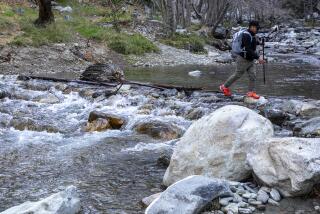Regional Trail Plan Approved by County : Recreation: The system of bikeways and hiking paths excludes the Santa Clara River Valley.
- Share via
Ventura County supervisors Tuesday approved a regional system of bikeways and hiking paths, but exempted the Santa Clara River Valley from the master plan because of farmers’ fears that their property values and businesses would be hurt.
The Board of Supervisors voted 4 to 0 to approve the plan, which proposes to link most of the county’s cities through a system of trails that would be built over the next 20 years. Supervisor John Flynn did not attend the meeting, but sent a letter urging the board to delay a vote.
Initially, the proposal called for a system of about 1,000 miles of trails linking all of the county’s 10 cities. The pathways would be used by bicyclists, hikers and equestrians.
But during a three-hour public hearing Tuesday, more than two dozen ranchers and citrus growers from the Santa Clara River Valley complained that the trail system would expose their property to vandalism, trash and possible lawsuits from injured hikers.
“We are not a park,” Santa Paula farmer Randall Axell said. “We are an industry. Show me an industry that has a trail running right through it.”
Robert Pinkerton, executive director of the Ventura County Cattleman’s Assn., criticized the supervisors for considering the plan without knowing how the county would pay for it.
“No one has said how much this is going to cost,” Pinkerton said. “Business people would never approve something without knowing how much it’s going to cost and how they were going to pay for it.”
His concerns were echoed by Rex Laird, executive director of the Ventura County Farm Bureau, who asked the board for assurance that it would not seek to obtain private land for the trail system through eminent domain.
Supervisor Maggie Kildee, whose district includes the Santa Clara River Valley, agreed with the farmers’ concerns and asked that the area be excluded from the trail system until those issues could be resolved.
“I’m strongly in favor of the idea that we need a trail in the Santa Clara River Valley,” she said. “But where it should be and how it works still needs to be worked out.”
Kildee said it may not be appropriate for some areas of the county to be included in the system, noting that farmers also have fears about the spread of crop-damaging pests.
“What’s good for urban areas may not be good for agricultural areas,” Kildee said.
Ron Blakemore, administrator of the Regional Trails and Pathways Program, said it was never the county’s intent to forcibly take private property for the trail system. He said much of the system would be on publicly owned land, which includes existing trails and flood control channels.
Blakemore said the system would also include some private property. But he said if an agreement could not be worked out with owners, the county would simply reroute the trail.
“We do not intend to infringe upon the rights of property owners,” Blakemore told the board.
Blakemore said the the next step is for the 38-member Regional Trails Advisory Committee to put together a financing plan to build and maintain the trail system. He said the panel, which is made up of residents and government officials, hopes to be able to bring back its plan within eight to 10 months.
Although the cost of the system is unknown, Blakemore said it would be financed through a combination of grants, donations and business sponsors. An adopt-a-trail system would be set up to encourage volunteers to maintain it.
So far, the only established parts of the system are the nearly 10-mile Ojai Valley Trail and a six-mile stretch along the Arroyo Simi in Simi Valley.
County officials said the system would take between 15 and 20 years to complete and would help the county meet federal air pollution regulations by providing an alternative for commuters.
More to Read
Sign up for Essential California
The most important California stories and recommendations in your inbox every morning.
You may occasionally receive promotional content from the Los Angeles Times.










